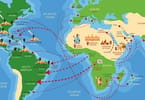According to a just-released UN report, tourism is finding a prominent, if not dominant, place in the world economy.
The report provides facts and figures to show the importance of tourism, and notes that Brazil and the Russian Federation is recovering again after a few years of decline.
In the first half of 2018, arrivals rose by 6 percent compared to the same period in 2017.
Asia, Pacific, and Europe grew by 7 percent, the Middle East by 5 percent, Africa by 4 percent, and America by 3 percent.
Integration with other sectors will help, the report states.
Focusing on South Asia, the outlook is moderately favorable, but economic trends are highly divergent across the countries. The downside risks have visibly increased in several economies.
Growth prospects in South Asia
Regional GDP is expected to expand by 5.4 percent 2019 and 5.9 percent in 2020, after an estimated expansion of 5.6 percent in 2018. Growth is expected to be supported by private consumption and, in some cases, investment demand, even as monetary policy stances tighten in some economies. But beyond these aggregate trends, the economic outlook is highly divergent across countries.
The Indian economy is expected to expand by 7.6 and 7.4 percent in 2019 and 2020, respectively, after expanding by 7.4 percent in 2018. Growth continues to be underpinned by robust private consumption, a more expansionary fiscal stance and benefits from previous reforms. Yet, a more robust and sustained recovery of private investment remains crucial to lift medium-term growth.
The Bangladesh economy is also set to continue expanding at a fast pace of above 7.0 percent, amid strong fixed investment, vigorous private consumption and accommodative monetary policy.
In contrast, the outlook in the Islamic Republic of Iran has visibly deteriorated due to the re-imposition of trade, investment and financial sanctions by the United States, and structural domestic weaknesses. The Iranian economy is estimated to have entered into recession in 2018, which is projected to deepen throughout 2019.
Economic growth in Pakistan is projected to slow in 2019 and 2020 to below 4.0 percent, after an estimated expansion of 5.4 percent in 2018. Pakistan’s economy is facing severe balance of payment difficulties, amid large twin fiscal and current account deficits, a visible decline in international reserves and mounting pressures on the domestic currency.
Risks and policy challenges
The world economy is faced with a confluence of risks with the potential to severely disrupt economic activity and inflict significant damage on longer-term development prospects. These risks include waning support for multilateral approaches; the escalation of trade policy disputes; financial instabilities linked to elevated levels of debt; and rising climate risks, as the world experiences an increasing number of extreme weather events.
South Asia faces several risks that could significantly alter the projected growth trajectory. On the domestic side, political uncertainties, setbacks in the implementation of reforms and, in some countries, security problems, may affect investment prospects. This is a crucial issue as the region needs to tackle infrastructure bottlenecks to promote productivity growth, encourage further poverty reductions and adjust to climate change.
On the external side, an abrupt tightening of global financial conditions and a further escalation of the ongoing trade disputes could pose risks to the regional outlook. More challenging external conditions can further expose macroeconomic imbalances and financial vulnerabilities associated with high fiscal and current account deficits and elevated levels of debt in some economies.
આ લેખમાંથી શું દૂર કરવું:
- In contrast, the outlook in the Islamic Republic of Iran has visibly deteriorated due to the re-imposition of trade, investment and financial sanctions by the United States, and structural domestic weaknesses.
- On the external side, an abrupt tightening of global financial conditions and a further escalation of the ongoing trade disputes could pose risks to the regional outlook.
- The report provides facts and figures to show the importance of tourism, and notes that Brazil and the Russian Federation is recovering again after a few years of decline.























